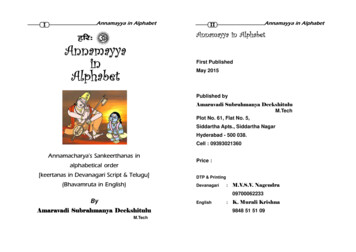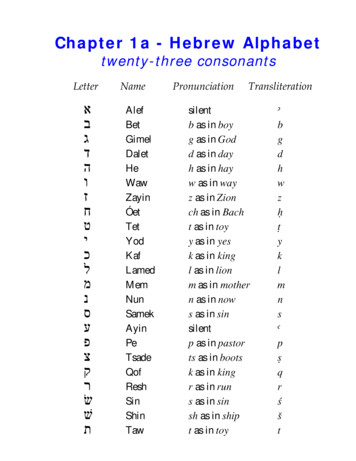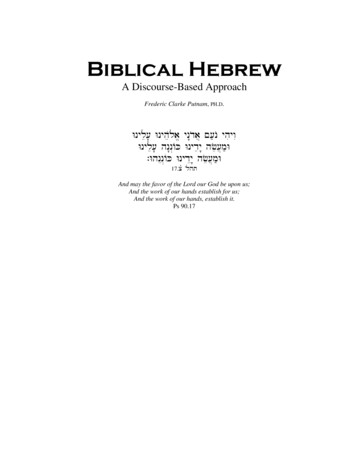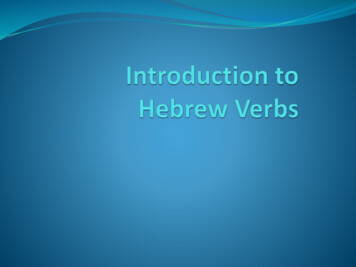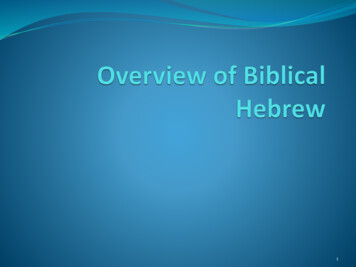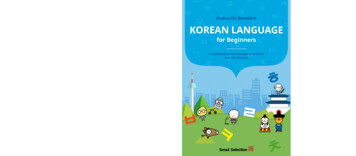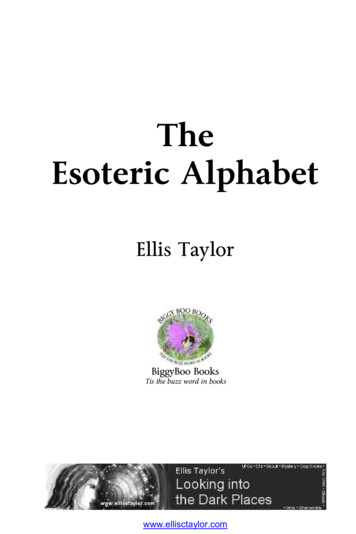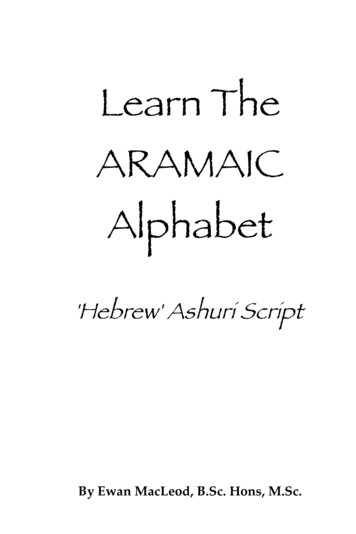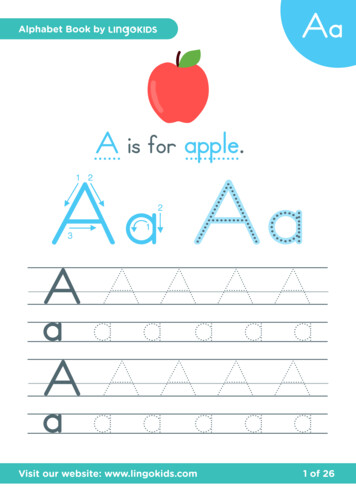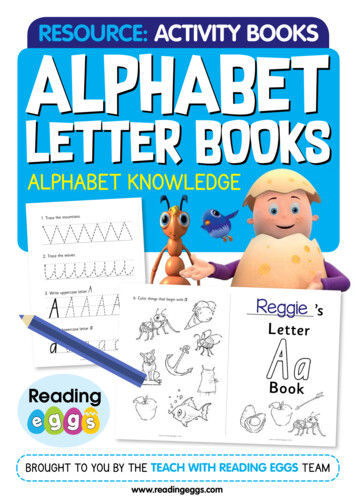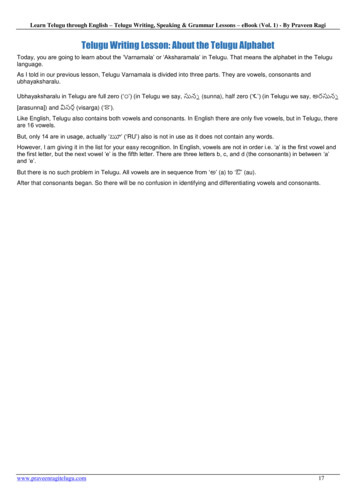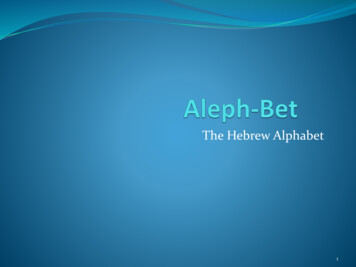
Transcription
The Hebrew Alphabet1
Aleph-Bet There are about 23 letters in the Hebrew alphabet. Some letters have more than one sound and some havespecial forms used at the end of words. Each letter has a numeric value used in gematria that Iwill include for your reference. Let’s get started!2
Aleph-BetLetterFinal Form Name/#Pronunciation א ּ , ב ב ג ד ה ו Aleph; 1(silent)Bet, Ve; 2ּ ב b as in boy; ב v as in vote ז Gimmel; 3 G as in gimmickDalet; 4D as in dollHe; 5H as in heyVav; 6V as in vote(Note Vav can also be spelled Waw)Zayin; 7Z as in zoo3
Aleph-Bet The next letter that we will learn on our list is call Het. The problem Americans face when pronouncing thisletter is that we don’t pronounce “Bach” as theGermans do. We’re going to try and fix that right now. To get the positioning of your tongue correct to makethis sound, pretend you are going to pronounce anEnglish “g” as in the word “get” But don’t actually make the “g” sound. Instead, note where your tongue is in the back of yourthroat.4
Aleph-Bet Now, lower the back of your tongue off your soft palate just a tiny bit; bring it back slightly and force a little airto pass through between your tongue and soft palate.Now add a vowel sound as you pronounce the letter.Practice several times to get it right.Remember, it is not a ck/ch sound; it’s more of abreathy h sound.You don’t have to over-do it and say it too harshly.5
Aleph-BetLetterFinal Form Name/# ח ט י ּ כ ּ , ךּ כ ל מ ם נ ן PronunciationHet; 8Ch as in BachTet; 9T as in toyYod; 10Y as in yellowKaf, Kha; 20ּ כ ּ K as in keep; כ / ּ ך Ch as in BachLamed; 30L as in lookMem; 40M as in meNun; 50N as in name6
Aleph-BetLetterFinal Form ס ע ּּ , פ פ צ ץ ק ר Name/#Samech; 60S as in sinAyin; 70(silent)Peh, Feh; 80P as in pay; F as in fameTsade; 90Ts as in catsQof; 100K as in keyResh; 200R as in rate7
Aleph-BetLetter ש ּ ש ּ ת Final FormName/#PronunciationShin; 300Sh as in shoeSin; 300S as in sinTav; 400T as in toy8
Aleph-Bet Let’s sing the Aleph-Bet song!Note: Song does not play inpdf version.Please play from lesson page.9
Aleph-Bet There are 6 letters that often have a dotcalled a "dagesh lene” inside them. These letters are ּ ב , ּ ג , ּ ד , ּ כ , פ ּ , ּ ת . They are often referred to as BeGaDKePHaTletters.10
Aleph-Bet Sometimes the dagesh in BeGeDKePHaT letters isnot a dagesh lene, but is a dagesh forte. If there is a full vowel (a vowel other than sheva)immediately preceding a consonant with a dagesh,it is a dagesh forte (strong dagesh), representing adoubling of the consonant in which it appears. All other letters (besides gutterals andBeGeDKeFaT letters) can take a dagesh forte.11
Aleph-Bet א , ה , ח , ע , and ר are known as gutturals. Their sound can’t be doubled; they don’ttake a dot in the center of them called a“dagesh forte.” As a result of the inability to double theirsound, vowel changes (resulting incompensatory lengthening) under gutturalsoften occur.12
Aleph-Bet We will discuss dagesh forte further when we discusssyllabification.13
Aleph-Bet There are 4 letters that change their form when theyappear at the end of a word; these are final sofit letters: כ becomes ּ ך מ becomes ם פ becomes ף צ becomes ץ 14
Aleph-Bet It is not unusual to confuse certain letters when firstlearning Hebrew. Please pay close attention to: ( ד dalet) and ( ר resh) ( ה he) and (ח het) ( ו vav) and ( ר resh) ( ו vav) and (ן nun sofit) ( ו vav) and ( י yod) ( ע ayin) and צ / (ץ tsade/tsade sofit)15
Aleph-Bet Notice that some letters have the same sounds but maybe transliterated differently to distinguish them. ( ח transliterated ch) and ( כ transliterated kh) ט and ת both have the t sound ס and ש ּ both have the s sound16
Aleph-Bet Hebrew vowels can be divided into two major groups:regular vowels and vowel letters. Please be aware that Hebrew grammars offer slightlydifferent vowel pronunciations for e-class and i-classvowels. You need to listen to audio and practice to get a goodhandle on vowels because it’s not an exact science.17
Aleph-Bet Long Vowels: A-classQamets E-classTsere O-classHolemָּּ ב ֵּּ ב ֹּּ ב a as in fathere as in they or ten*o as in hope18
Aleph-Bet Short Vowels A-classPatach E-classSeghol I-classHireq O-classQamets Hatuf U-classQibbutsַּּ ב ֶּּ ב ִּּ ב a as in fatherָּּ ב ֻּּ ב o as in hopee as in meti as in pin ormachine*u as in pull orrule*19
Aleph-Bet B. M. Rocine teaches, “A qamets in a closed andunaccented syllable is called a qamets-hatuf andshould be pronounced as a holem.” The qamets hatuf occurs only in closed, unaccentedsyllables, as in חָּכמָּה or כָּּל־ . The qamets hatuf neverappears in a closed, accented syllable.20
Aleph-Bet Reduced (Hateph) Vowels A-classHateph Patach E-classHateph Seghol O-classHateph Qametsֲּּ ב ֱּּ ב ֳּּ ב a as in amusee as in metallico as in commit orhope21
Aleph-Bet Vowel letters are also know as matres lectionis. They are vowels written with the consonants ה , ו , י .22
Aleph-Bet Vowel letters written with ( ה He) can only appear atthe end of a word: A-classQamets He E-classTsere HeSeghol He O-classHolem He בָּּה בֵּּה בֶּּה בֹּּה a as in fathere as in theye as in beto as in role23
Aleph-Bet Vowel letters written with ( ו Vav): O-classHolem Vav U-classShureqֹּּ בּו ּ בּ ּו o as in roleu as in ruler24
Aleph-Bet Sometimesּ ּו can be a consonant and sometimes avowel. If it is accompanied by a vowel, it is a consonant. The ּ ּו in צִּו ָּּה is accompanied by a qamets, so it’s aconsonant that is pronounced “v”.25
Aleph-Bet Vowel letters written with ( י Yod): E-classTsere YodSeghol Yod I-classHireq Yod בֵּּי בֶּּי בִּּי e as in eighte as in beti as in machine Vowels written with Yod ( )י or Vav ( )ו are oftenreferred to as historically or unchangeably long vowels.26
Aleph-Bet An Israeli cantor taught me that: Tsere is pronounced as an “e” in “met.” Hireq is between an “i” in “sit” and “machine;” it’s closerto “i” as in “machine.” Hebrew grammars say to pronounce a patach-yod-vav orqamets-yod-vav at the end of a word as “av.” ( בּ ָּּנ ָּיו wouldbe pronounced “ba-nav.”)27
Aleph-Bet Defective writing refers to vowels that are writtenwithout their consonant. Three patterns of defectivevowels are: Holem Vav (ֹּּ )בּו written as Holem (ֹּּ )ב Shureq (ּ ו ּ ּ )ב written as Qibbuts (ֻּּ )ב Hireq Yod ( )בִּּי written as Hireq (ִּּ )ב (plene)(defectiva)28
Aleph-Bet There are two basic types of shevas: Silent Shevas (ּ )ב are never pronounced ortransliterated. Vocal Shevas (ּ )ב have a short or hurriedpronuncication and sound like the a in amuse. Bear in mind that some grammars refer to “Reduced(Hateph) Vowels” as “Compound Shevas.”29
Aleph-Bet Biblical Hebrew A Compact Guide, Miles Van Pelt, Zondervan, Grand Rapids, Michigan, copyright 2012.Biblical Hebrew An Introductory Grammar, Page H.Kelly, William B. Eerdmans Publishing Company, GrandRapids, Michigan, copyright 1992.Learn Biblical Hebrew, 2nd Edition, with Audio CDRom, John H. Dobson, Piquant Editions, Ltd., Carlisle,CA3 9GR, United Kingdom.Learning Biblical Hebrew A New Approach UsingDiscourse Analysis, B.M. Rocine, Smyth & HelwysPublishing, Inc., Macon, Georgia, copyright 2000.http://www.hebrew4christians.com/Grammar/Unit Two/unit two.htm30
Hebrew lessons compiled by: Beth C. Mehaffeyhttps://holyhiway.wordpress.comContact: betmeh2 at gmail.com31
There are about 23 letters in the Hebrew alphabet. . pdf version. Please play from lesson page. 9. Aleph-Bet There are 6 letters that often have a dot called a "dagesh lene” inside them. These letters are ּ, ּ H, ּ, ּ Q, ּ Z, ּ. They are often referred to as BeGaDKePHaT letters. 10. Aleph-Bet Sometimes the dagesh in BeGeDKePHaT letters is not a dagesh lene, but is a dagesh forte. If .
